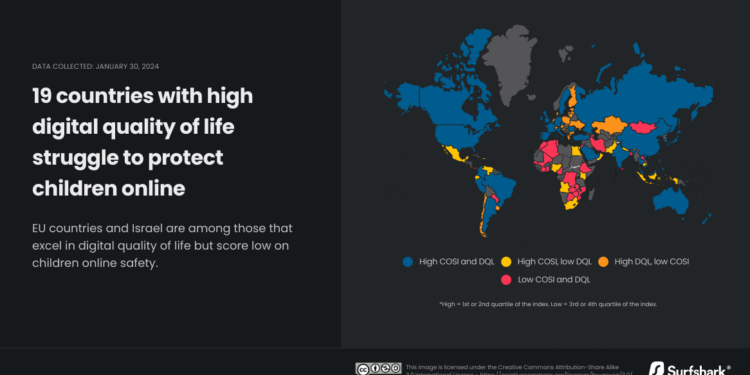19 countries with high digital quality of life struggle to protect children online
While countries with an overall higher standard of digital life more often experience enhanced child online safety, this is not a universal truth.
Safer Internet Day is observed every February to advocate for a safer and more positive internet for everyone, particularly children.
To mark this event, Surfshark’s research hub has released an analysis exploring the connection between the global Children’s Online Safety Index—a national-level metric designed to help countries monitor the online safety of their children—and two other indexes: the Digital Quality of Life, which examines overall digital wellbeing, and the KidsRights Index, a global ranking that measures the respect for children’s rights worldwide.
“In an age where our children leave their digital footprints before they can walk, ensuring their online journey is safe is not just a responsibility but also a crucial obligation. When we analyze how children’s online safety correlates with the global focus on kids’ rights and the overall quality of digital life in 100 countries, we observe that countries with a higher standard of digital life often exhibit higher levels of children’s online safety.
“However, in some countries, particularly in Europe, a high quality of digital life does not guarantee a significant level of online protection for kids. Systematic measures are essential to safeguard children in the digital space—not only in their immediate environments, such as family and school but also at national and global levels,” says Agneska Sablovskaja, Lead Researcher at Surfshark.
Digital safety paradox
While countries with an overall higher standard of digital life more often experience enhanced child online safety, this is not a universal truth. Nations leading the Child Online Safety Index (COSI), on average, score a commendable 0.6 out of 1 on the Digital Quality of Life (DQL) index. In stark contrast, countries at the lower spectrum of the COSI achieve an average of only 0.3 on the DQL index, a significant divergence from the global median of 0.5.
The paradox emerges more starkly in certain parts of the world, mostly Europe, where a high quality of digital life does not ensure a high level of online protection for children. Notably, 19 countries in the top two tiers of the DQL find themselves in the two lowest categories of the COSI index scale. These include 14 European countries: Austria, Bulgaria, Croatia, Denmark, Estonia, Finland, Greece, Latvia, Lithuania, the Netherlands, Poland, Slovakia, Switzerland, and Ukraine; 3 Asian countries: Israel, Bahrain, and Kazakhstan; and 2 South American countries: Chile and Uruguay.
Dr. Yuhyun Park, founder of the DQ Institute, which releases COSI annually, said, “We have witnessed seven years of consistently high, 70% cyber-risk exposure rates among 8-18-year-old children and youth. We now refer to this phenomenon as a ‘persistent cyber-pandemic.’ Today, with the fast deployment of generative AI, the metaverse, and XR-like (Extended Reality) pervasive devices, digital technology is changing children’s lives even more, yet there is minimal discussion regarding their potential harmful effects. Global coordinated action, akin to addressing climate challenges, is imperative, and we can no longer delay.”
The intersection of kids rights and online protection
In the realm of children’s defense in the digital domain, a pattern emerges that underscores the significant link between robust children’s rights enforcement and heightened online safety for the young. Countries that enforce robust children’s rights usually achieve high ratings in children’s online safety.
Those in the highest category of the Child Online Safety Index have an average KidsRights Index score of 697 out of 1000, closely following the overall average of 694. In stark contrast, countries in the lowest COSI category average a KidsRights Index score of 559. This stark disparity sheds light on the ongoing challenges and complexities in the global endeavor to shield our children in the online universe.
Diving deeper into predictive capabilities, the DQL index serves as a more reliable predictor for children’s online safety than the KidsRights index, with correlation coefficients with COSI of -0.47 and -0.23, respectively. For instance, the United Kingdom and New Zealand rank at the bottom tier of the KidsRights scale due to low scores on its environment pillar, but they are at the top categories for both COSI and DQL. Thus, ensuring overall digital wellbeing within a country is a crucial factor in protecting children online.
About Surfshark
Surfshark is a cybersecurity company focused on developing humanized privacy and security solutions. The Surfshark One suite includes one of the very few VPNs audited by independent security experts, an officially certified antivirus, a private search tool, and a data leak alert system. Surfshark is recognized as the Independent’s Editor’s Choice for Best Value VPN 2023.
Source:norvanreports


